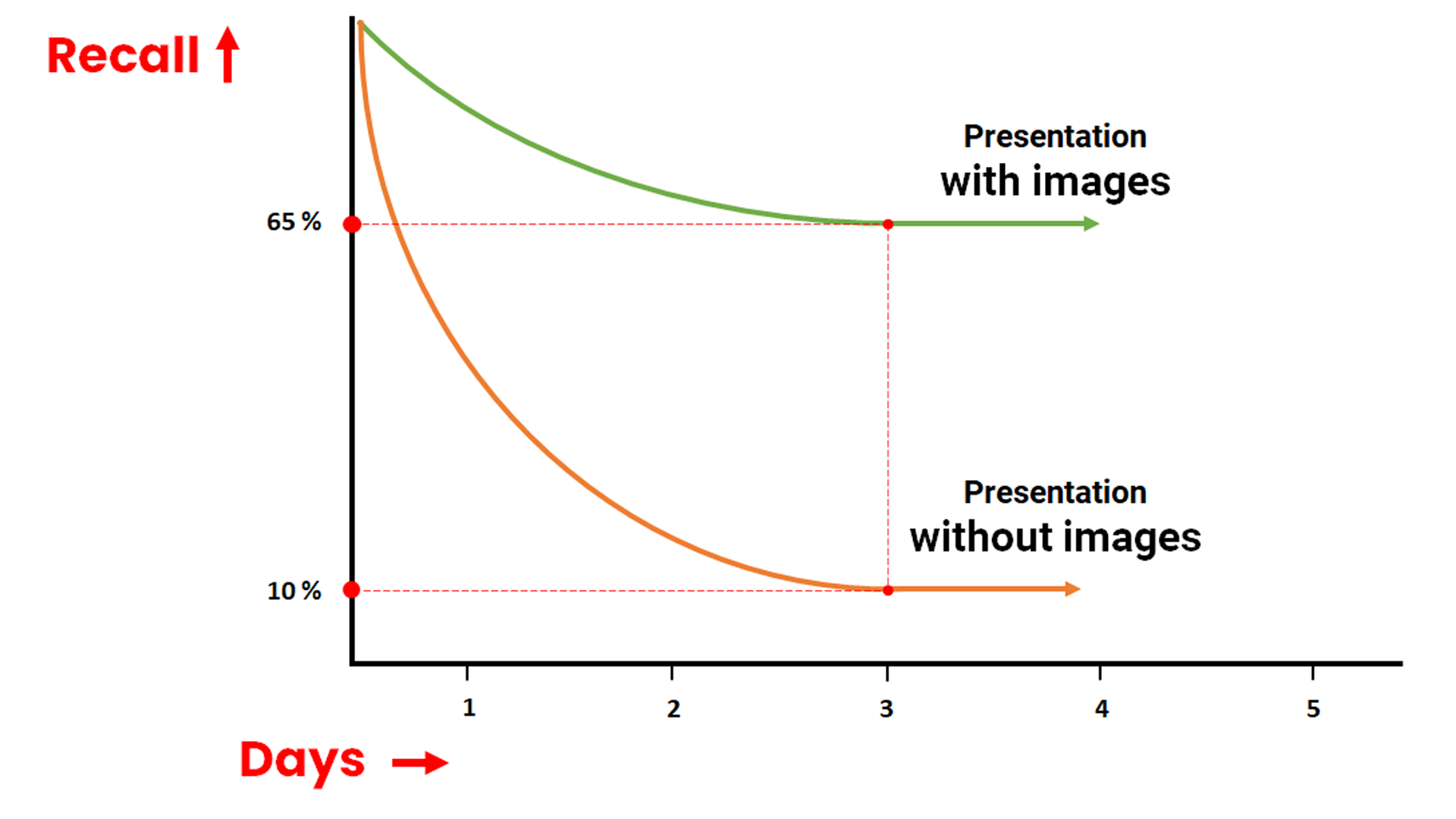Importance of Images in Presentations

An Image is worth a thousand words.
When we think of presentations, certain facets spring up in our minds. Precise pictures and videos support different facts, data, and texts to make them etched in audiences’ minds.
A large set of facts can be portrayed in one related image or photo, and not only that, when audiences come across that image after watching the presentation, they summon up most of the points the image carried there.
According to various findings, an image bears a greater recall-value than a horde of facts presented in texts.
The images you use for your PowerPoint presentation can profoundly affect viewer engagement, self-esteem, and retention. Selecting the appropriate PowerPoint graphics is critical to the presentation’s overall success.
The Benefits of visual communication
The right graphic will compliment your written materials and bolster your arguments while Irrelevant or Decorative photographs will appear out of place and detract from your content’s value. Rather than that, consider the concepts you wish to convey to consumers and seek out images that will assist in cementing these messages.

- Visual communication is a term that refers to visual methods of conveying information to a specific audience rapidly and without the use of words.
- Visual communication enables interactive, user-friendly, and responsive information dissemination.
- Visual information should be designed in such a way that it is capable of effortlessly transmitting data to receivers.

Additionally, your images should be cohesive with your brand so that customers can readily establish the link. For instance, color schemes and visual language can be effective strategies to personalize and enhance the value of photographs.
Choosing the appropriate image for your text does not have to be difficult. Here are some recommendations to assist you in making the best choice:
- What narratives are you attempting to convey to your audience?
- What form of graphic could assist in luring readers further into the content?
- Which photos are most appropriate for your brand?

Images Grab Audience Attention
Images have a strong motivating effect on readers, urging them to engage with your material.
Understanding how and which images assist you in achieving your marketing objectives, can help you make the best selections for your site, resulting in positive growth for your firm.
Capturing an audience’s attention is the first step toward engaging them, but with the proliferation of distractions around us, this is becoming an increasingly challenging process. According to this Forbes article, including stats or images before presenting essential information is an excellent method to capture your audience’s attention.
After capturing your audience’s attention, it’s critical to ensure they retain the information you delivered.
Engagement for the sake of engagement, I’m guessing, does not align with your key performance indicator. When we associate a meaningful image with information, we recall 65% of it three days later, compared to 10% when we do not associate an image.

Thus, using pertinent pictures can contribute to creating a more memorable presentation.
To take things a step further, create live polls and quizzes using the photos from your presentation to assess your audience’s comprehension of the knowledge you presented, resulting in higher overall presentation success rates.
Utilize services that integrate with PowerPoint so that you may seamlessly integrate live polls into your presentation slides.
Images assist the audience in comprehending your presentation
Texts, voice-over, music, and other different features become more effective and impactful in tandem with images in varied presentations.
Images create an engagement with viewers quickly, and after they read the textual content with those images, this engagement becomes abiding. Images are generally uncomplicated and are gulped by the audience easily.
Simultaneously, they go a long way in making the audiences keep hold of facts and details based on the engagement between them and the audiences.
Moreover, these meaningful images make the other contents of your presentation evocative, and the presentation in itself carries a variety.
But, using an image in your presentation must make sense by being a vital cog in the entire mechanism in conveying the core message.
Images are more inclusive
Many speakers make the mistake of believing that everyone in the audience thinks similarly.
Assuming that everyone thinks the same way we do, we overlook that audiences are linguistically, culturally, and neurodiverse.
Because not everyone comprehends at the same level, portions of your speech are likely to pass over the heads of members of your audience. To assist you in delivering a valuable and interesting presentation to everyone, choose powerful images that are more likely to penetrate their defenses.
Images that are visually appealing help establish your credibility
Using polished, well-constructed images, films, and infographics will instantly boost your reputation.
Using a link to another person’s YouTube video or a generic stock photo does not elicit the same level of admiration and respect as using your visual content.
Professionally created images enhance the appearance and feel of your presentation while also communicating a message of professionalism and trustworthiness about you and your company.

Images aid in the communication of the message provided during your presentation
We all have to convey tough concepts at times, but the key to properly breaking the content down into digestible chunks.
Another trick is to incorporate some effective visual aids. Whether it’s flow charts, word clouds, or pertinent images, incorporating these visual aids into your presentation will simplify your content and engage your audience.

flow charts

word clouds

pertinent images
They have the potential to elicit an emotional response
Consider what excellent presenters do best: they elicit an emotional response to the material they present, even if unfamiliar with the subject. Steve Jobs and others have discovered the primary secret to capturing their audience’s attention – emotional connection.
By eliciting an emotional response, you may maintain an audience’s attention and interest for a longer amount of time and maximize the impact of your involvement.

Images are a convenient way to establish an emotional connection. Why? To begin, research has established that humans are visual creatures. Visual information accounts for approximately 90% of the information conveyed to our brain. As a result, it’s easier for us to connect deeper with visuals.
Second, visuals may convey a greater number of cues than words. This is because visuals can encapsulate complicated and abstract notions such as emotions and color and efficiently communicate them to an audience.
These additional cues can elicit a stronger emotional response from the audience, making their engagement more gratifying for both you and them.
They strengthen the clarity of your message
Consider describing a new hue to an audience using only words. You will quickly see that this is impossible.
Occasionally, using only words makes it difficult to convey a message to your audience, particularly when explaining something abstract or visual.
By including appropriate supporting images in your presentation slides, you limit the possibility of misunderstandings between you and your audience. This is especially critical if you debate and vote on a significant decision and require consensus. They succinctly express the message conveyed throughout your presentation.
Author : Saurabh Mishra
Publishing Date : 28 January, 2022

 +91-9540344454
+91-9540344454 